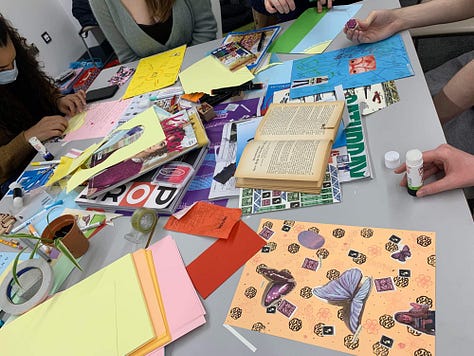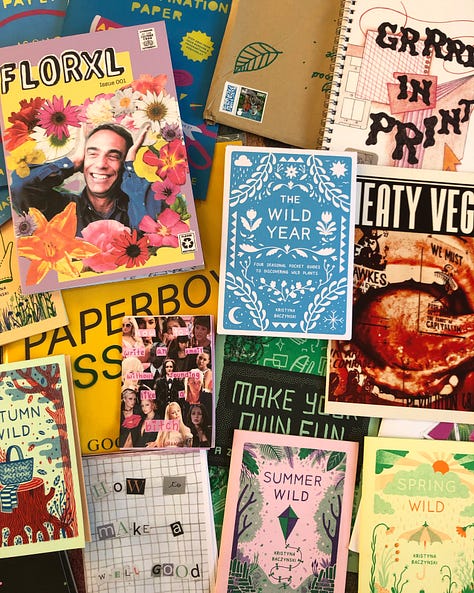Swapping screens for zines: how cutting-and-sticking could boost your grades, reduce stress and improve your uni experience.



What if I told you that crafting alongside your studies could reduce stress, help you find friends and even boost your assignments? Welcome to the underground trend sweeping the student world in Oxford: zine making.
What is a zine?
You might have seen zines popping up across YouTube and TikTok, but they go way back. Pronounced ‘zeen’, they’re basically Instagram plus Twitter but in paper form, and without the toxicity of likes and weirdo creeps in the comments. In fact, zines were kind of social media before social media existed.
They started back in the 1930s, as a way for people to geek out about the stuff they loved and share it with others. This was the pre-Zuckerberg dark ages - without social media, people needed to connect and chat, and zines were the perfect way. 1930s creatives started making their own little pamphlets full of art, writing and collages as a way to share thoughts and ideas. Like social media now, zines didn’t require a publisher - you could literally do it yourself.
Zines really took off in the 1970s with the Punk movement - a lot of the iconic punk collage aesthetic stems from zines at the time, like Sniffin’ Glue - a zine that discussed all things punk music and culture. Because you can publish whatever you want, without traditional gatekeepers, they can provide a great outlet for minority groups. You might have heard of GalDem - that started as a zine! Or if edgy 90s feminism is more your thing, look up the Riot Grrrl movement - zines are a whole underground world.
The zine scene today
Despite the dominance of social media, zines are just as relevant as ever. As a self-confessed social media addict, the idea of stepping away from screens to do some craft sounds great. Instead of hindering zines, the internet has furthered their reach: there are over 1000 different zines available on Etsy alone, and zine-related videos have over 149.2M views on TikTok.
In Oxford, zine culture is thriving, particularly in student circles. The recent zine fair at the Bodleian Library was a melting pot of subcultures, all connected through zines. Contributors included Queering Spires, celebrating queer life in Oxford, Zindabad Zine, a hub for young people affected by diaspora, and Cuntry Living, an intersectional feminist zine. Even Oxford University got involved, launching their own LGBTQ+ Society zine, PRISM.
Academics are also catching onto the zine trend. In fact, scholarly interest in zines (that’s clever academic researchers who write papers) has increased by 1,700% over the last 28 years. Basically, everyone’s talking about zines, from underground communities to gown-and-cap wearing academics. The reason for this might be their accessibility: they’re cheap, easy and can be made by anyone.
Oxford Brookes University has recently launched their Student Zine Scheme, a new project exploring the benefits of zine making alongside a degree. Jill Cacmak is a current Brookes student who took part in a university-led zine workshop as a form of creative brainstorming. Jill told me that she found the experience relaxing, while also allowing her to flesh out her assignment topic. She used existing magazines as a springboard for her ideas, collaging images and typography from a variety of publications.
Jill particularly enjoyed how collage allowed her to find ideas and topics in the physical magazines that she wouldn’t have thought to search for on the internet. By putting together ideas from a variety of magazines, Jill was able to piece together her own idea in an exciting new way. But her favourite thing about zine making? There was no right or wrong. Unlike her usual academic work, she could put ideas down without overthinking, and just take the time to experiment. And yet zine making wasn’t procrastination: Jill was able to use her creative brainstorming session to flesh out and inform a future assignment.
Yasmin Arnould went to a zine workshop during her university degree, and has loved zines ever since. She told me that the act of making a zine ‘completely took away the stress’ related to her dissertation. Like Jill, the experience allowed Yasmin the space to think about her assignments away from a screen, letting her imagination run wild without distractions. She described zine making as ‘gymnastics’ for her brain, letting her thoughts come together in a creative, experimental way.
Sina Leasuasu is a zine maker who leads workshops with young people in Oxfordshire. She decided to share her love of zine making with minority groups; Sina has found zines beneficial for expressing her own truth as a mixed-race woman, and wanted to spread the good vibes. She told me that she sees zine making as a form of self-care, allowing her to brain dump her feelings. Sina thinks zine making could be particularly therapeutic for young people and students, as a ‘great creative outlet’. As a teenager, Sina appreciated the freedom of expression that zines gave her, especially during an emotionally turbulent time. She uses zines to ‘channel any emotions’ she’s going through, often keeping her zines to herself rather than sharing them, and purely enjoying the process.
The future of student zine making
So, what’s next for zine making? The Oxford Brookes Zine Scheme looks set to continue, and I do wonder whether they might be onto something; zine making is clearly beneficial to student wellbeing and creative brainstorming, no matter what course you might be taking. Yasmin Arnould spoke enthusiastically about the idea of universities setting up zine making societies as a way to make connections and meet new people, while taking a study break. Or as Sina mentioned, using zines as a way to creatively and emotionally brain dump, as a form of self-care. In the words of art god Neil Buchanan: why not try it yourself? Grab some paper, felt tips and scissors, and get making. You never know what the benefits might be.

